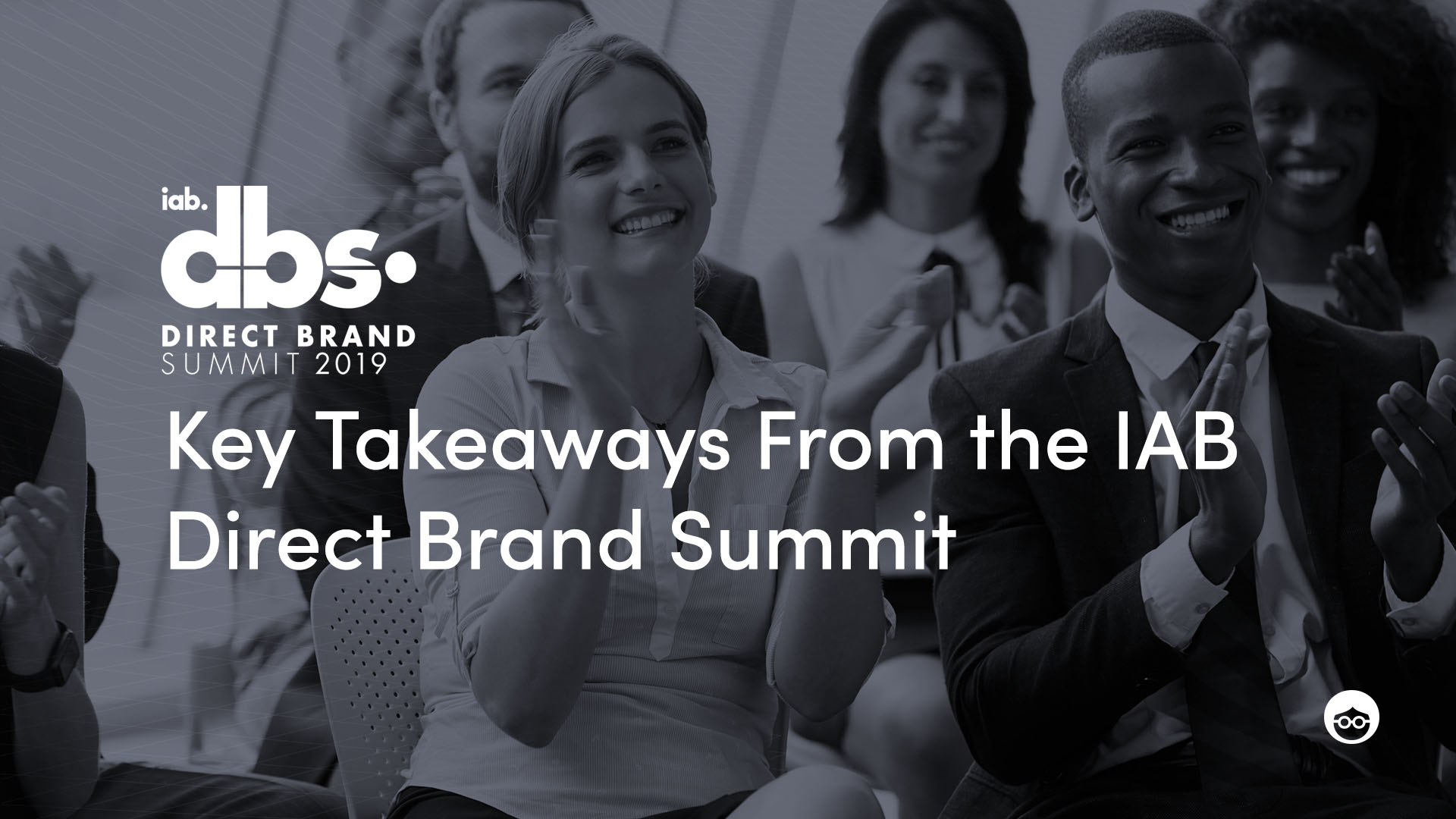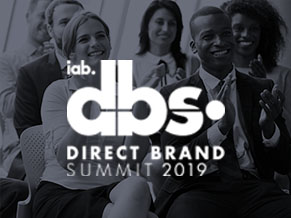IAB Direct Brand Summit Recap: Collaborate, Diversify, and Storytell

DTC brands are often referred to as “disruptors” for good reason — they are single-handedly disrupting every stage of the brand game, from supply chain and logistics to marketing and advertising.
And as DTCs disrupt, we’re all trying to keep up — learning during every interaction gained.
Thus 2019, or as I like to call it, the year of the Direct-to-Consumer conference.
As brands try to learn from DTCs, and vendors try to create solutions for DTCs, we’ve seen a huge spike in the number of marketing conferences themed toward disruption. And this year’s IAB Direct Brand Summit was no exception, flooded with the amazing brands you can’t help but come across numerous times on any given day — be it on your morning MTA commute or scrolling through your Instagram feed.
Powering through the cross-conference repetition unfolded three pervasive themes these innovative brands are taking on to continue challenging the status quo:
- Collaborate | From Internal Silo-Removal to External Partnership
- Diversify | From Internal Hiring to External Channel Promotion
- Storytell | From Internal Hoorahs to External Customer Dynamics
Challenger Collaboration
When DTC brands first took the market by storm, they brought a legitimate intimidation factor to traditional brands. While the legacy brands had much higher capital and brand notoriety to their names, the DTCs were bringing speedier levels of convenience and personalization to market, originally unheard of by the incumbents, often due to the third parties between the brand and the consumer.
And not only were they taking market share, they were taking it almost overnight given their fast-growth mindsets — again, unheard of traditionally for brands who’ve been around for decades, gaining share and brand loyalty over time.
As a result, many traditional brands began creating internal DTC-like teams, or “innovation labs,” or further, acquiring them, to disrupt the disruption being created by their DTC counterparts.
More recently, we’ve seen a shift beyond acquisition, to true partnership and collaboration — a hot topic at the Direct Brand Summit as we gained inside looks to three disrupting duos:
- Mattress Firm and Purple
- J. Crew and Hatch
- Lord & Taylor and Le Tote
It’s a win-win collaboration. DTCs gain the efficiency, scale, and physical footprint the incumbents have to offer while mitigating risk through heightened capital. Incumbents gain the experiential personalization and speed-to-market the DTCs have to offer. Together, they are bringing the best of both worlds, without trying to be the other.
“Study the traditional brands,” said Joe Megibow, CEO at Purple, “they’ve been doing this for decades.” And while the incumbents could do it themselves, Lisa Greenwald, CMO at J. Crew, added “it’s more newsworthy when you’re doing it with someone else — the media loves it. Create synergy, and leverage someone else’s value.”
The same level of collaboration could be said for the internal teams at the DTC brands, as Performance or Growth teams have become the new marketing normal. “You don’t have to have separate silos of brand and performance — whether on budgets or teams that execute on it,” said Vivian Chang, VP of Growth at The Clorox Company.
The cross-collaboration of the teams allows for bonding, beyond branding, as initiatives can be launched across the funnel, instead of the typical down-funnel approach — gaining notoriety, conversion, and retention along the way.
💡 Brainy Tips:
- Consider collaborating with your DTC or traditional counterpart for heightened learnings and buzz-worthy content.
- Break down the walls between your Performance and Brand Awareness.
- Think brand and response — having a direct response-mindset through the storytelling of branding.
Diversity in Disruption
With the rise of digital disruption has come a rise in mediums in which to disrupt. But it wasn’t always an embarrassment of channel riches.
“Ten years ago, we weren’t really talking about the direct to consumer relationship — we were trying to convince people that it was safe to shop on the internet, period,” said Nicole Williams, VP of Brand Marketing at Mack Weldon.
As the comfort settled in over the years, the convenience of online shopping followed, placing customer acquisition at the forefront, as challenger brands looked to scale quickly and raise their next rounds of funding. Those quick, inexpensive gains were often found through the duopolies of Search and Social.
Now, brands are taking a small (but mighty!) step back, shifting their acquire-at-all-costs mindsets to customer-centric dynamics, creating an even bigger shift to the diversification of channels. This has opened the gate for other channels to provide ROAS-friendly support — from connected TV placements through Hulu to interest-based native advertising through Outbrain.
“We’re flipping the direct response foundation on its head to get consumers to leverage the experiences unique to our brand,” said Allison Stadd, VP of Marketing at BARK, “letting this [uniqueness] power the marketing mix, with direct response as the foundation, so we’re not overly reliant on Facebook as it’s getting louder and oversaturated.”
Williams added, “2020 is going to be all about diversifying our channels — moving away from being heavily focused on Email and Facebook Advertising, and finding more levers — more irons in the fire.”
Flipping the script to take an internal look, diversification goes beyond the channels you’re utilizing to connect to your consumers, noted Mayur Gupta, CMO at Freshly. “Technology can take you so far, but you need a human element.”
Brands are taking an inclusive look at diversity, beyond the basic demographic differences, but even with their professional backgrounds, to be able to bring fresh perspectives and solutions to the same problems. We’re seeing the outcome of this as even DTC product offerings are becoming consumer-inclusive, as brands avoid over-indexing on any particular category.
💡 Brainy Tips:
- Diversify your marketing mix beyond Social and Search to reach audiences during heightened moments of brand discovery.
- Diversify your hiring panels to avoid unconscious biases from the get-go, making room for future creative problem-solving.
- Diversify your product offering to answer to the needs of a wider audience pool.
Storytelling Savviness
The biggest factor that sets DTC brands apart is their first-party data, and the level of personalization they reach as a result. Originating as a digitally native brand creates a closer initial relationship with the consumer, inspiring the onset of trust between them. And as power has shifted more and more to the consumer, this idea of trust is becoming ever more important.
“Take the funnel out of the equation, and realize how people are interacting with your brand,” said Kyle Maurer, VP of Global Digital at Monster Energy. “We’re focusing on the actual people we’re trying to reach… before we start adding end-objectives and KPIs. People matter, and DTCs are uniquely positioned on understanding the people who are the consumer — not the demographics, or the metrics — the people.”
And that’s just it — looking at your customer as a human instead of a CPA (the cost associated with acquiring them). Creating that human element is where the art of storytelling begins. “We’re not trying to make a quick sale and never see you again — we’re trying to build a relationship,” said Rich Fulop, Co-Founder & CEO at Brooklinen.
Video storytelling is considered the intangible element that comes from relationship-building. It’s functional, symbolic, emotional, transparent, and authentic — all building blocks of a high-performing, customer-centric story. Through purpose-backed initiatives, it drives more meaningful connections with the end consumer.
This is where native advertising plays a prevalent role in the broad digital advertising space. Not only is it placed within the look and feel of the online experience your audience is interacting with — it provides further interest-based context, surrounding your brand with content that matters to them.
Again, this storytelling goes beyond your external experiences. But it is also a tremendous tool for an internal hoorah — continually exciting your team beyond your brands’ purpose, and connecting to audiences that aren’t just potential customers, but potential hires.
💡 Brainy Tips:
- Consider native ad platforms (like Outbrain!) for a more holistic brand experience.
- Remember that the consumer you’re looking to acquire is human just like you, and allow that realization to seep into your story for driving meaningful connections.
The ever-evolving innovation of the DTC world is increasingly compelling as it continues to keep us all on our toes — as marketers, as partners, and more importantly, as consumers.
There’s simply no room for mediocrity or complacency as they continually challenge the status quo at all stages. And there are constant learnings as a result, most recently: collaboration, diversification, and storytelling, from the inner workings of your brand to the external experiences provided to your audiences.




